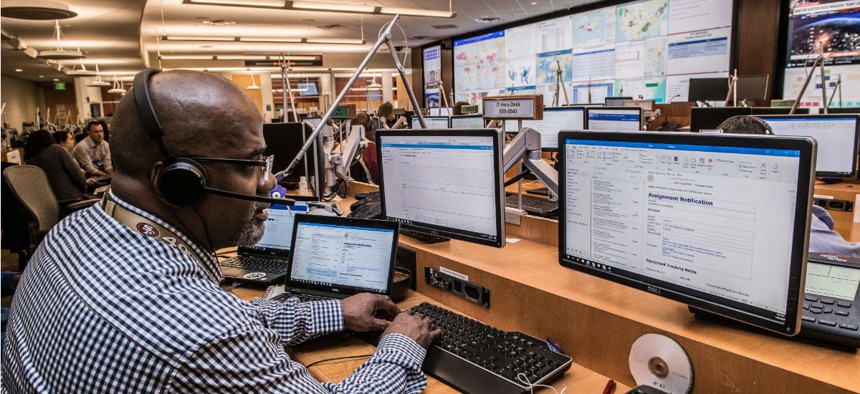
The CDC activated its Emergency Operations Center to assist public health partners in responding to the COVID-19 outbreak. James Gathany/CDC
The Federalism Divide Is Shading Government’s Response to COVID-19
We can’t afford a government where the odds of an effective attack on the novel coronavirus depend on where citizens live.
The coronavirus is inescapably rippling across the country. But underneath the virus’s spread lie three important issues: 1) It struck first in blue states. 2) State and local officials, impatient with the federal response, are seizing the reins. 3) How they do so will determine whether our assault against the virus helps us shrink the polarization that has poisoned American politics.
Of course, there isn’t a partisan way of treating patients. It’s unseemly, in fact, even to suggest that COVID-19 might be a red or blue issue.
The initial outbreaks, however, flared up in blue states: Washington, followed by California, New York, and Massachusetts. As of March 10, a dozen mostly red states, especially in the Deep South and the West, had diagnosed few or no cases.
It’s hardly the case that the virus pays attention to the partisan divide. The states that saw the first cases were the hyper-connected, high-tech states, where the governments and leading companies quickly took aggressive action without waiting for the feds. Amazon, Google, Facebook, and Microsoft asked their Seattle-based employees to work from home. When they shut down employees’ travel, that decision effectively shut down Austin’s hugely popular South by Southwest festival.
Many state and local officials, frustrated by frictions with the feds, stepped out on their own. New York state imposed a containment area around New Rochelle and, when supplies of Purell ran short, devised its own hand sanitizer, which Governor Andrew Cuomo quipped had “a very nice floral bouquet.” San Antonio Mayor Ron Nirenberg complained about confusion over federal testing.
Along the way, a truly national problem became a partisan clash. President Donald Trump tweeted a complaint about “Do Nothing Democrats” and called Washington Governor Jay Inslee “a snake.” Local officials countered that they too often have felt alone. “This has been mostly a state and local effort. The federal government has been sort of behind the times,” Sacramento County Director of Health Services Peter Beilenson told Politico.
That the virus crisis has become a forum for polarization is scarcely surprising. As I found in my research for The Divided States of America: Why Federalism Doesn’t Work, the kind of government Americans get increasingly depends on where they live. Deep polarization in the country springs from precisely the differences that are surfacing in the battle against COVID-19.
The divide spills over even to just how big a problem the virus poses. A Reuters poll conducted from March 2-3 revealed that Democrats were twice as likely as Republicans to believe that the virus posed an imminent threat to the country. Rush Limbaugh argued that the virus was “the common cold,” something “being weaponized” to attack Trump. New York’s Governor Cuomo countered that the federal response could be characterized as “bad government and poor planning.”
It’s scarcely surprising that the virus, like everything else in American politics and policy, falls into the chasm of polarization. But two things are about to become crystal clear.
One is that this virus cares nothing about red state versus blue state politics. The virus itself will decide whether it’s an imminent threat and it’s not going to pay attention to where it wanders.
The other is that the federal government will surely shape broad guidelines, but state and local governments will be responsible for carrying them out. From decisions about containment zones to strategies in dealing with nursing homes, we’ll discover yet again that the driving realities of governance are what happens on the front lines. Federalism matters, and this virus will provide a searching test of how well Madison’s grand design works in the 21st century.
We can’t afford a government where the odds of an effective attack on the virus depend on where citizens live. And we surely can’t afford to allow our need for a truly nationwide attack on the virus to deepen the already large chasms in American politics. It’s a searing reminder about the need for building bridges across government’s boundaries, at a time when so many forces are eroding its pillars.
Donald F. Kettl is the Sid Richardson Professor at the LBJ School of Public Affairs at the University of Texas at Austin. He is the author of The Divided States of America: Why Federalism Doesn’t Work (Princeton University Press). He can be reached at kettl@austin.utexas.edu.







